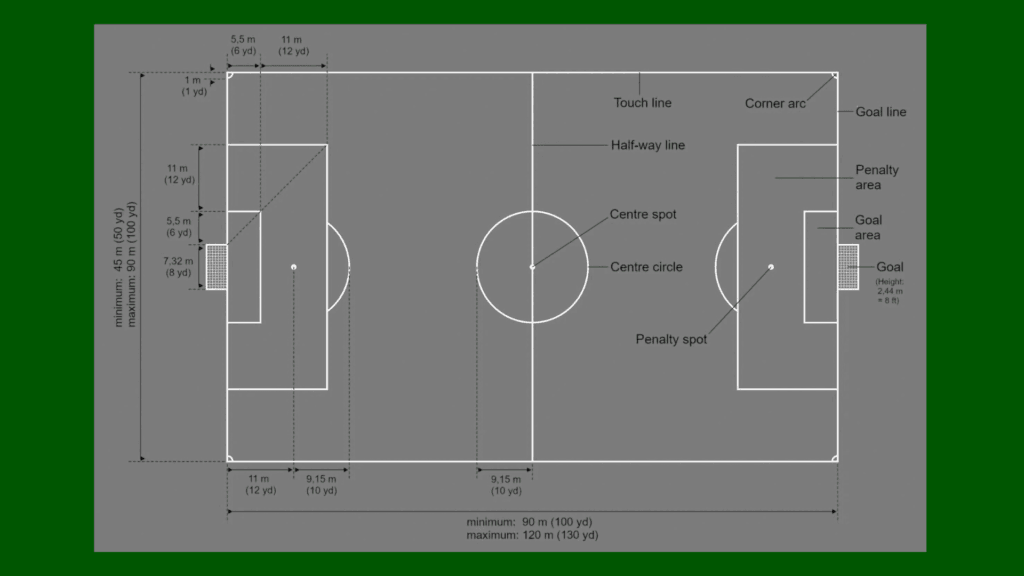
Introduction : The width of a football (soccer) field is an essential aspect of the game’s overall dimensions, influencing how teams play and strategize during matches. According to FIFA’s Laws of the Game, the width of a football field is regulated to ensure a standard playing environment across different venues. The Width Of the Football Field Measured In Feet 160 feet. This measurement is consistent across professional, college, and high school football fields.
Standard Width Dimensions

Minimum Width: 64 meters (210 feet)
Maximum Width: 75 meters (246 feet)
Importance of Width in Football
The width of the field plays a significant role in several aspects of the game
1. Tactics and Formation
Team Shape: Larger area enables teams to keep much of their players apart from the opposition which gives room to create. This may result in the formation of games for teams that highlight the breadth, 4-3-3 or 3-5-2, where the wingers and wing-backs
Attacking Play: Some of the ways that width is able to be used is to pull the opposition’s defence wider, creating passing lanes through the middle of the pitch for other players. This is handy in manufacturing attacks that include crossing and cutting inside the defenses.
2. Defensive Strategies
Compactness: If teams play on narrower fields though, they might use a more compact defensive shape that stops opponents from getting space. As a result, you tend to play more of a physical game, hoping to physically win a duel and trying to hang onto the ball.
Pressing: The width of the field can also affect pressing strategies. Teams may choose to press higher up the pitch on wider fields to limit the opposition’s ability to exploit space.
3. Player Development
Skill Development: Playing on a wider field encourages players to develop their dribbling, passing, and spatial awareness skills. They learn to make quick decisions and find open teammates, which is crucial for their growth as athletes.
Fitness and Endurance: Players must cover more ground, which means wider fields, and that provides fitness and endurance. This is a very helpful aspect to build stamina and agility to youth players.
Measures of a Football Field
The dimensions of a football (soccer) field are standardized by FIFA to ensure consistency and fairness in the game. Understanding these measures is essential for players, coaches, and fans, as they influence gameplay, tactics, and strategies. Below is a detailed overview of the key measures of a football field.
Width of football field measured in feet in meters
FIFA has a range of width between the football field, between 210 feet (64 meters) to 246 feet (75 meters). With this standardized width, there’s enough space for players to maneuver and implement different tactics during a whole match. To understand these dimensions, coaches and players must want to determine the best way to approach the field.
Football Field Measurements
| Measure | Meters | Feet |
|---|---|---|
| Length (Minimum) | 100 meters | 328 feet |
| Length (Maximum) | 110 meters | 361 feet |
| Width (Minimum) | 64 meters | 210 feet |
| Width (Maximum) | 75 meters | 246 feet |
| Goal Area Depth | 5.5 meters | 18 feet |
| Penalty Area Depth | 16.5 meters | 54 feet |
| Center Circle Radius | 9.15 meters | 30 feet |
| Corner Arc Radius | 1 meter | 3.3 feet |
| Goal Width | 7.32 meters | 24 feet |
| Goal Height | 2.44 meters | 8 feet |
| Penalty Spot Distance | 11 meters | 36 feet |

Tips for Understanding the Width of a Football Field Measured in Feet
Understanding the width of a football field is crucial for players, coaches, and fans alike. Here are some helpful tips to keep in mind:
1. Know the Standard Dimensions
The width of a football field ranges from 210 feet (64 meters) to 246 feet (75 meters). Familiarizing yourself with these measurements can help you visualize the playing area and understand the dynamics of the game.
2. Consider Field Layout
The width affects how teams set up their formations and strategies. Wider fields allow for more expansive play, encouraging the use of wingers and creating space for attacking movements. Coaches should consider these dimensions when designing training sessions and game plans.
3. Adapt Training Drills
When conducting practice drills, ensure that the training area reflects the width of a standard football field. This helps players develop skills and tactics that are relevant to actual gameplay, enhancing their ability to adapt during matches.
4. Utilize Markings Effectively
Understanding the field’s width can help in setting up proper markings for training sessions. Use cones or markers to replicate the width of the field, allowing players to practice positioning and spacing effectively.
5. Analyze Game Strategies
Observing professional matches can provide insight into how teams utilize the width of the field. Take note of how teams spread out to create opportunities and how they defend against wide plays, which can inform your own tactical approaches.
6. Emphasize Communication
Encourage players to communicate effectively about spacing and positioning on the field. Understanding the width allows players to make better decisions about when to spread out or compact their formation based on the flow of the game.
Conclusion
The width of a football field, ranging from 64 to 75 meters (210 to 246 feet), is a critical factor that influences gameplay, tactics, and player development. Understanding the implications of field width can help coaches and players devise effective strategies that capitalize on the available space, ultimately enhancing their performance on the pitch. Whether a team prefers a compact style or a more expansive approach, the width of the field plays a vital role in shaping their overall game plan.
People also ask
1. What is the process of determining a playing field, which is twenty-by-thirty?
Determining a playing field that measures twenty-by-thirty typically involves measuring and marking the dimensions on the ground, ensuring that the length is 30 units and the width is 20 units, using appropriate tools like measuring tapes and stakes.
2. What is the Width of football field in yards?
The width of a football field ranges from 70 to 82 yards, which is equivalent to 64 to 75 meters. This standardized width allows for various playing styles and strategies, ensuring a consistent playing environment across different venues.

Leave a Reply